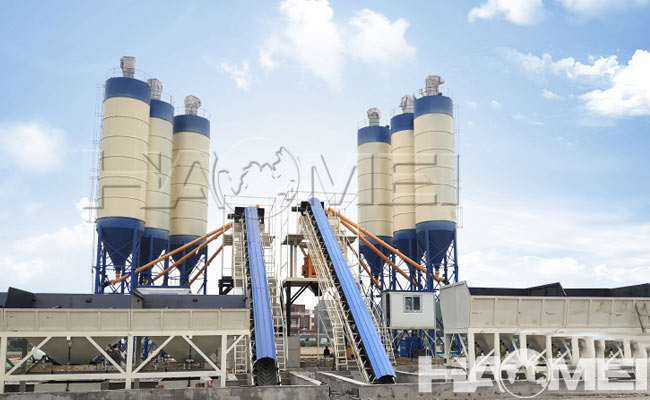Categories
- Case & News (50)
- Blog (564)
Dust in concrete batching plants primarily originates from the storage, transportation, mixing, and unloading of raw materials (sand, gravel, cement, etc.). The key to dust control is “source suppression + process collection + end-of-pipe treatment.”

Common dust control methods including:
1. Source Suppression: Reducing Dust Generation
– Enclosed Storage of Raw Materials:
Use enclosed silos or greenhouses for sand and gravel yards, cement silos, fly ash silos, etc. to prevent windblown dust. Install sealed covers on cement and other powder silos to reduce dust leakage from breather valves.
– Reducing Material Head Gaps:
Use low-height designs or incorporate buffer devices (such as deflectors) at transfer points in conveying links (such as belt conveyors and screw conveyors) to reduce dust generated by material impact.
– Wetting:
Use a sprinkler system to regularly apply water to sand and gravel stored outdoors (if the process allows) to maintain surface moisture and suppress dust. Simultaneously spray water during vehicle loading to reduce dust generation during unloading.
2. Process Collection: Capture Dispersed Dust
– Dust Hood + Duct Collection:
Install dust hoods at high-dust locations (such as the mixer inlet, conveyor belt transfer point, and cement silo discharge port) and extract dust to dust removal equipment through negative pressure ducts.
– Local Sealed Isolation:
Use sealed enclosures for core equipment such as the mixer and powder metering silo to reduce dust spillage. Belt conveyors are equipped with enclosed corridors to create a local negative pressure environment.
3. End-of-Pipe Treatment: Purify Collected Dust
– Bag dust collector:
Utilizes filter bags to filter dust, achieving a dust removal efficiency exceeding 99%. It is suitable for handling high-concentration, fine-particle dust (such as cement powder and fly ash) and is the most commonly used, high-efficiency equipment in concrete batching plants.
– Cyclone dust collector:
Uses centrifugal force to separate larger dust particles. It is often used as a pre-treatment device in conjunction with a bag dust collector (to separate coarse dust first, reducing filter bag load).
– Wet dust collectors:
These use a water curtain or mist to absorb dust (such as a spray tower). They are suitable for handling dust with high humidity levels, but may generate wastewater and require a corresponding treatment system.
– Electrostatic precipitators:
These use electrostatic force to absorb dust, offering high efficiency. However, the equipment is expensive and maintenance-intensive, making them less commonly used in concrete batching plants.
4. Auxiliary measures: Reducing secondary dust
– Vehicle and road management:
Vehicles entering and leaving the factory must pass through a washing platform (for tires and bodies) to prevent dust from entering the road. Factory roads are hardened and regularly watered, and windbreak and dust suppression nets are installed.
– Intelligent monitoring:
Dust concentration sensors are installed to monitor dust concentrations within the factory and at key locations in real time, enabling the activation of spraying or dust removal equipment to achieve precise control.
Which dust control method is most effective? A single measure alone cannot completely control dust. A combination of “source containment + high-efficiency dust removal equipment (bag filters) + process collection” is most effective for the following reasons:
– Source containment fundamentally reduces dust dispersion and reduces the burden of subsequent control (for example, enclosing silos can reduce open-air dust by over 80%).
– Bag filters achieve a filtration efficiency of over 99.9% for fine dust particles (such as cement powder), far exceeding cyclone dust collectors (70%-90%) and wet dust collectors (80%-95%). They also eliminate secondary wastewater contamination and are suitable for handling high-concentration powders in concrete batching plants.
– Process collection (hoods and ducts) precisely captures dust at the point of generation, preventing it from dispersing and becoming difficult to control. Combined with bag filters, they can control localized dust concentrations to below 10mg/m³ (in compliance with national standards).
– In addition, supplementary measures (such as vehicle washing and intelligent monitoring) can further reduce secondary dust generation, ensuring stable overall control.
In summary, concrete batching plants need to combine their own dust-generating characteristics and give priority to the core combination of “closed storage + bag dust collector + dust collection system”, supplemented by humidification, monitoring and other measures to achieve efficient dust control.